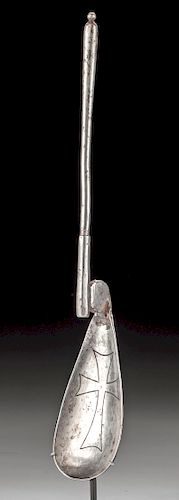Byzantine Silver Devotional Spoon, Cross- Art Loss Cert
Lot 78
About Seller
Artemis Gallery
686 S Taylor Ave, Ste 106
Louisville, CO 80027
United States
Selling antiquities, ancient and ethnographic art online since 1993, Artemis Gallery specializes in Classical Antiquities (Egyptian, Greek, Roman, Near Eastern), Asian, Pre-Columbian, African / Tribal / Oceanographic art. Our extensive inventory includes pottery, stone, metal, wood, glass and textil...Read more
Categories
Estimate:
$10,000 - $15,000
Absentee vs Live bid
Two ways to bid:
- Leave a max absentee bid and the platform will bid on your behalf up to your maximum bid during the live auction.
- Bid live during the auction and your bids will be submitted real-time to the auctioneer.
Bid Increments
| Price | Bid Increment |
|---|---|
| $0 | $25 |
| $300 | $50 |
| $1,000 | $100 |
| $2,000 | $250 |
| $5,000 | $500 |
| $10,000 | $1,000 |
| $20,000 | $2,500 |
| $50,000 | $5,000 |
| $100,000 | $10,000 |
| $200,000 | $20,000 |
About Auction
By Artemis Gallery
Feb 13, 2020
Set Reminder
2020-02-13 10:00:00
2020-02-13 10:00:00
America/New_York
Bidsquare
Bidsquare : Exceptional Antiquities, Asian, Ethnographic
https://www.bidsquare.com/auctions/artemis-gallery/exceptional-antiquities-asian-ethnographic-4848
An important one-day auction featuring museum-worthy examples of Egyptian, Greek, Roman, Etruscan, Near Eastern, Far East / Asian, Pre-Columbian, African / Tribal, Oceanic, Native American, Spanish Colonial, Russian, Fossils, Ancient Jewelry, Fine Art, so much more! Artemis Gallery info@artemisgallery.com
An important one-day auction featuring museum-worthy examples of Egyptian, Greek, Roman, Etruscan, Near Eastern, Far East / Asian, Pre-Columbian, African / Tribal, Oceanic, Native American, Spanish Colonial, Russian, Fossils, Ancient Jewelry, Fine Art, so much more! Artemis Gallery info@artemisgallery.com
- Lot Description
Near East / Holy Land, Byzantine Empire, ca. 5th to 6th century CE. An elegant spoon that would most likely have formed part of a treasure, perhaps with other items. It features an oval bowl incised with a cross and a circular drop. At the point where it abuts, the stem is hexagonal, thereafter circular, broadening gently to terminate in a spherical nodule. Stylistically, it compares with some of the later early Byzantine spoons known from prominent collections which formed part of larger church treasures. Churches were essentially treasure houses in this period with a great deal of wealth deposited in churches from the age of Constantine onwards; in this sense, they represented the banks of their day. The successful reign of Constantine was essentially bankrolled by the confiscation of pagan gold and silver and this was later deposited in churches across the Roman empire. Size: 1.65" W x 8.75" H (4.2 cm x 22.2 cm); 9.7" H (24.6 cm) on included custom stand; silver is 95% pure; total weight is 42 grams
Aside from imperial donations of this kind, in the early Byzantine period, the most common sources of benefaction were the so-called subscription donors. These were individuals, often of quite modest wealth, who contributed in a relatively small way towards the construction or upkeep of a church, or its decoration, or presented it with individual items, produce or property. Perhaps the best-known example of this phenomenon is depicted on a floor mosaic in a church at Kissufim in Israel. This shows two females, one offering coins, the other a small vessel. The present spoon would have certainly been part of a gift to a church in the early Byzantine empire. Its high quality indicates that it would have been offered by a subscription donor of a somewhat higher social standing than those benefactors depicted on the mosaic mentioned above.
Accompanied by digital Art Loss Register Certificate, reference number S00106627
Some of the best-known parallels are several spoons from the celebrated Kaper Koraon and associated treasures in the collection of the Walter’s Art Gallery in Baltimore. Four of these form part of the Hama Treasure (Inv. 57.651, 57.649, 57.647, 57.648, sixth to seventh centuries AD); and eight of these, of a similar date range comprise the Antioch Treasure (Inv. 37.35, 37.36, 37.37, 37.38).
Provenance: private Connecticut, USA collection; ex-private UK collection, acquired between the 1970s and 2015
All items legal to buy/sell under U.S. Statute covering cultural patrimony Code 2600, CHAPTER 14, and are guaranteed to be as described or your money back.
A Certificate of Authenticity will accompany all winning bids.
We ship worldwide and handle all shipping in-house for your convenience.
#152761Very slight bending to handle but overall in beautiful condition with rich patina.Condition
- Shipping Info
-
All shipping is handled in-house for your convenience. Your invoice from Artemis Gallery will include shipping calculation instructions. If in doubt, please inquire BEFORE bidding for estimated shipping costs for individual items.
-
- Buyer's Premium



 EUR
EUR CAD
CAD AUD
AUD GBP
GBP MXN
MXN HKD
HKD CNY
CNY MYR
MYR SEK
SEK SGD
SGD CHF
CHF THB
THB















